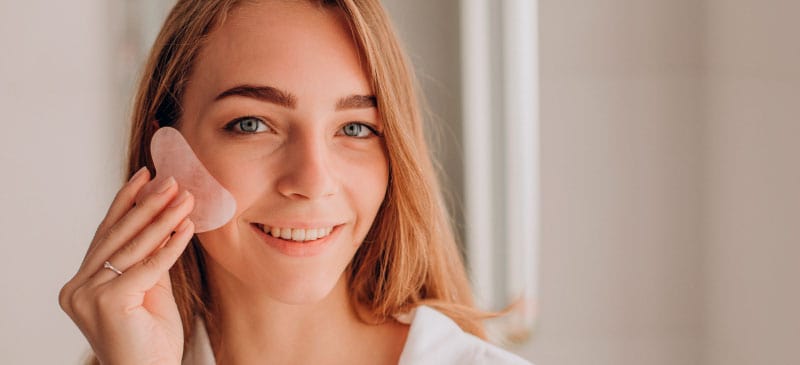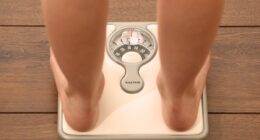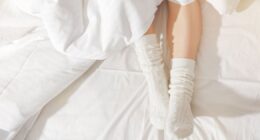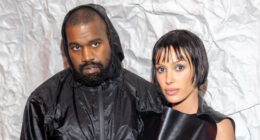

Have you heard about the “botox of the Far East”? There are no needles, and you can even do it yourself. It’s a natural therapy called gua sha. It is an ancient massage technique that is now mainstream, especially facial gua sha.
Considering how easy it is to find the necessary tools and perform facial gua sha in the comfort of your own home, it’s no wonder why it’s so popular. But does gua sha work?
A New York–based gua sha facial specialist, Britta Plug, says it does. “With this type of treatment, we’re moving lymph, which carries away toxins, or in this case, blackheads, and stimulating the chi or prana. It tones the muscles and firms the skin, and, plus, it’s deeply relaxing. This is one of the biggest benefits of gua sha, because when the client is receiving it, they get to really sink into that parasympathetic nervous system.”
Sounds intriguing, doesn’t it?
What Is Gua Sha?
Pronounced “gwa sha,” gua sha is an ancient (likely overly 2,000 years old) Chinese therapy that uses a tool to rub or scrape the skin’s surface in long strokes. The purpose is to help move energy, known as qi or chi, around the body. Traditional medicine practitioners have used this method for centuries to boost circulation, increase blood flow, break up scar tissue, help chronic pain and generally improve the health of the entire body.
This type of therapy can be used on areas of the body such as the back, arms, legs and buttocks, and it can also be used on the face. It feels similar to a massage but rather than a hand, you’re feeling the gliding strokes of a hard tool with rounded edges against your skin. Oil is used to ensure the tool glides easily and doesn’t tug on your skin.
Gua sha is also sometimes referred to as coin rubbing or coining therapy. Coining can be defined as an ancient treatment method that is used to rid the body of “heat” or “negative energies.” The gua sha technique is also called “spooning.” Most practitioners use tools made out of natural materials such as gem stones, animal bone or animal horn, but some even use soup spoons or coins. The similarity that all of these tools share? A rounded edge.
If you’re comparing gua sha versus the Graston Technique, both forms of natural therapy are non-invasive, use tools to manipulate the soft tissue and are used for pain-related issues. However, the Graston Technique is focused more on breaking up fascia restrictions, while gua sha aims to increase circulation and lymphatic flow (such as with lymphatic drainage massage).
To this day, gua sha is still widely practiced in China and South East Asia. In Vietnam, it goes by the name of “cao gio”; in Indonesia, the term “kerokan” is used. When used on the body traditionally, practitioners purposely create petechiae, which are non-raised patches of brown-purple or red spots due to bleeding under the skin. The idea is that this micro-trauma can help the body to break up scar tissue and increase energy flow. However, such intense skin scraping and muscle scraping is controversial in some circles (see below).
Related: Face Roller Benefits + How to Use
Benefits
1. Pain Relief (Including Back and Neck)
One of the top uses of gua sha on the body is for pain. A randomized study published in the journal Complementary Therapies in Medicine evaluated the effects of gua sha on chronic lower back pain symptoms and inflammatory biomarkers in elderly subjects. The elderly study subjects with chronic back pain were treated with gua sha or a hot pack.
The researchers found that during the one-week follow-up period, while both treatments improved movement of the lower back, the amount of pain reduction and disability improvement were notably greater in the gua sha–treated group compared to the hot pack group.
Another randomized controlled clinical trial also found that gua sha has “beneficial short-term effects on pain and functional status in patients with chronic neck pain.” (Craniosacral therapy has also been found to help neck pain.)
2. Boosts Skin Circulation
Many people love gua sha facial massages because of their potential skin-boosting and anti-aging benefits. Since research demonstrates gua sha can boost circulation, it’s not surprising this type of facial is known to have impressive effects on the health and appearance of skin. It is said to decrease puffiness, clear congested pores, firm the skin and make it generally more radiant than it was pre-treatment.
Cecilia Wong, a Manhattan celebrity facialist has used facial gua sha on her clients for years, started practicing the technique on herself at the age of 10. She says, “What I love most about gua sha is that results are immediate, and you can’t say that about everything. After gua sha, my skin is lifted, tightened, and any puffiness is gone.”
If you’re looking to use gua sha for face wrinkles and fine lines, there are no guarantees, but if you are going to see any improvements in signs of aging (or in other skin concerns like acne), then consistency is key. If you do see improvement, it won’t be overnight (unfortunately), but if you make it a regular practice, you just may find yourself looking more youthful.
READ RELATED: Succinic Acid Benefits for Skin + How to Use It
3. Breast Engorgement (During Lactation)
When nursing, it’s possible to experience breast engorgement, which is when the breasts overfill with breast milk, becoming swollen and often painful. Engorgement can be a challenge to successful breastfeeding and sticking with breastfeeding if the situation does not resolve.
One scientific paper reveals how a woman experiencing breast engorgement benefited from the gua sha she received from nurses the second day after giving birth up until leaving the hospital. Along with other helpful factors (including education on proper breastfeeding techniques), gua sha appears to have played a role in helping this mother to continue breastfeeding successfully.
Gua sha breast massage using light pressure is also used to increase circulation and lymphatic drainage of the breasts, or even to possibly promote firmer breasts.
4. Perimenopausal Syndrome
Perimenopause is unpleasant, as symptoms may include sleeplessness, irregular periods, anxiety, hot flashes, fatigue and more. Can gua sha help?
A study researched gua sha as a potential remedy, in conjunction with conventional therapy for eight weeks. While the control group only had the conventional therapy, the experimental group had weekly 15-minute gua sha treatments as well. The study authors concluded that gua sha therapy was effective as well as safe in helping to relieve perimenopausal symptoms, plus improving the quality of life for the participants. They say it warrants further study.
Gua Sha Tools
You can’t obtain any of the potential gua sha benefits if you don’t have the appropriate tool. Gua sha tools for the face and body come in several shape options and are usually made out of real crystal or stone. These tools are used to stroke the skin’s surface.
A gua sha face tool varies in price depending upon its material. For example, there are amethyst, rose quartz and jade tools. The ones that are not made using true crystal or stone will cost less, possibly as little as $6. If you’re looking for jade stone benefits from true jade massage therapy, you’ll want to make sure your gua sha tool is made from real jade, which will likely cost somewhere around $30. Same thing goes for amethyst or rose quartz (the real versions will cost more than the ones that just look like they’re made of these crystals).
What are the best gua sha tools? It really is often a matter of personal preference. If you’re choosing a tool for the face, you want one with curves and rounded knobs that work well with your facial curves. The shaping is also designed to apply pressure to the meridian points on the face to encourage a better flow of Qi, or vital life energy. In terms of what the tool is made out of, you can make your choice based on color or if you’re into the possible healing properties of crystals, you can make your choice based on that.
Gua Sha Facial Technique
According to the holistic facialist and “gua sha guru,” Julie Civiello Polier, these are the basic steps to giving yourself a great gua sha facial:
- Start with a clean face and clean hands.
- Apply facial oil (four to 10 drops) over the face and neck, starting with the forehead and moving downward (following the direction of lymph fluid drainage).
- Warm your tool between your hands.
- Sweep up your neck on both sides, going very lightly over the Adam’s apple.
- Sweep under your chin from the middle of your face out to your earlobe, keeping your tool flat.
- Sweep from the middle of your chin over your jawline toward your earlobe. You can also gently jiggle at your ear to encourage the fluid to drain down the neck to the lymph nodes at the base, just above your collarbone.
- Sweep underneath your cheekbone, aiming to move fluid that tends to be stored here and direct it towards your hairline. You can also lightly and gently jiggle your tool at your hairline.
- Sweep over your cheekbones, finishing at the hairline.
- Sweep under your eyes extra gently. Julie adds, “I love sweeping from the corner of the eye moving in toward the midline. The muscle contracts in this direction and the lymph has little rivers flowing down from the eyes all the way from the inner corner of the eye to the outer corner. But if it feels better to sweep from the inner corner of the eye to the hairline, then do that — this is a more traditional direction for gua sha.”
- Sweep over the eyebrow out toward the hairline and then up from the brow bone over the forehead to the hairline. To cover this area best, do it in three to five smaller sections.
- Sweep from between the eyebrows and up to the hairline.
- Sweep from the middle of the forehead out to the hairline.
- Perform the same steps on the other side side of your face.
- Finish the treatment by sweeping down the neck to the collarbone.
You should sweep each area three to five times. It’s important not to sweep over each area too many times, because this may cause counterproductive overstimulation. Try to keep your tool almost flat to your skin at about 15 degrees. Don’t hesitate to try out using tools with various shapes and also using various sides of a tool to best fit the contours of your face.
Precautions and Side Effects
If you feel unsure about practicing gua sha therapy at home for the first time, you can always get a facial or massage from a professional who has a gua sha certification.
Gua sha is generally not recommended for people who:
- Bleed easily
- Take blood thinners
- Have deep vein thrombosis
- Have an implant (like an internal defibrillator or pacemaker)
- Have cystic acne
- Have a skin infection or open wound
- Have tumors or cancer
- Have any medical condition that affects the skin or veins
If performed incorrectly or with too much pressure, there are potential risks and side effects. Gua sha side effects can include bruising caused by the bursting of tiny blood vessels (capillaries) near the surface of the skin. Other side effects may include swelling, tenderness or pain.
If really excessive pressure is used on the muscles, this can tear the membrane that covers them. Although not common, this level of tissue trauma can lead to muscle swelling and rhabdomyolysis or “rhabdo,” a rare but life-threatening condition in which muscles release a protein that can overtax the kidneys. If you experience rhabdo symptoms, including post-treatment pain that worsens, fever, dizziness, pressure, warmth or increasing redness in the treated area, after gua sha, you should seek immediate medical attention.
The skin should not be broken as a result of gua sha scraping. While broken skin is not common, there is a chance this can occur and pose the risk for infection. This is one of the reasons why it’s so important that practitioners sterilize their tools between clients. You should also make sure to clean your tools between home uses.
Check with your healthcare provider before trying gua sha if you are pregnant, nursing, have a medical condition or are currently taking medication.
Final Thoughts
- Gua sha is an ancient, non-invasive Chinese therapy that uses a tool to rub or scrape the skin’s surface in long strokes.
- The goal of this massage technique is to help move energy, known as qi or chi, around the body.
- Traditional medicine practitioners have used gua sha for centuries to boost circulation, increase blood flow, break up scar tissues, help chronic pain and generally improve the health of the body.
- When this therapy is practiced using intense strokes of pressure, it becomes more controversial. The greater the pressure used with any gua sha treatment, the higher the likelihood of adverse side effects.
- Benefits (using light pressure) may include: reduced pain, increased circulation, improvements in breast engorgement and lymph flow and a reduction in cellulite, breakouts and signs of aging.
!function(f,b,e,v,n,t,s)
{if(f.fbq)return;n=f.fbq=function(){n.callMethod?
n.callMethod.apply(n,arguments):n.queue.push(arguments)};
if(!f._fbq)f._fbq=n;n.push=n;n.loaded=!0;n.version=’2.0′;
n.queue=[];t=b.createElement(e);t.async=!0;
t.src=v;s=b.getElementsByTagName(e)[0];
s.parentNode.insertBefore(t,s)}(window, document,’script’,
‘
fbq(‘init’, ‘3475171552810057’);
fbq(‘track’, ‘PageView’);




